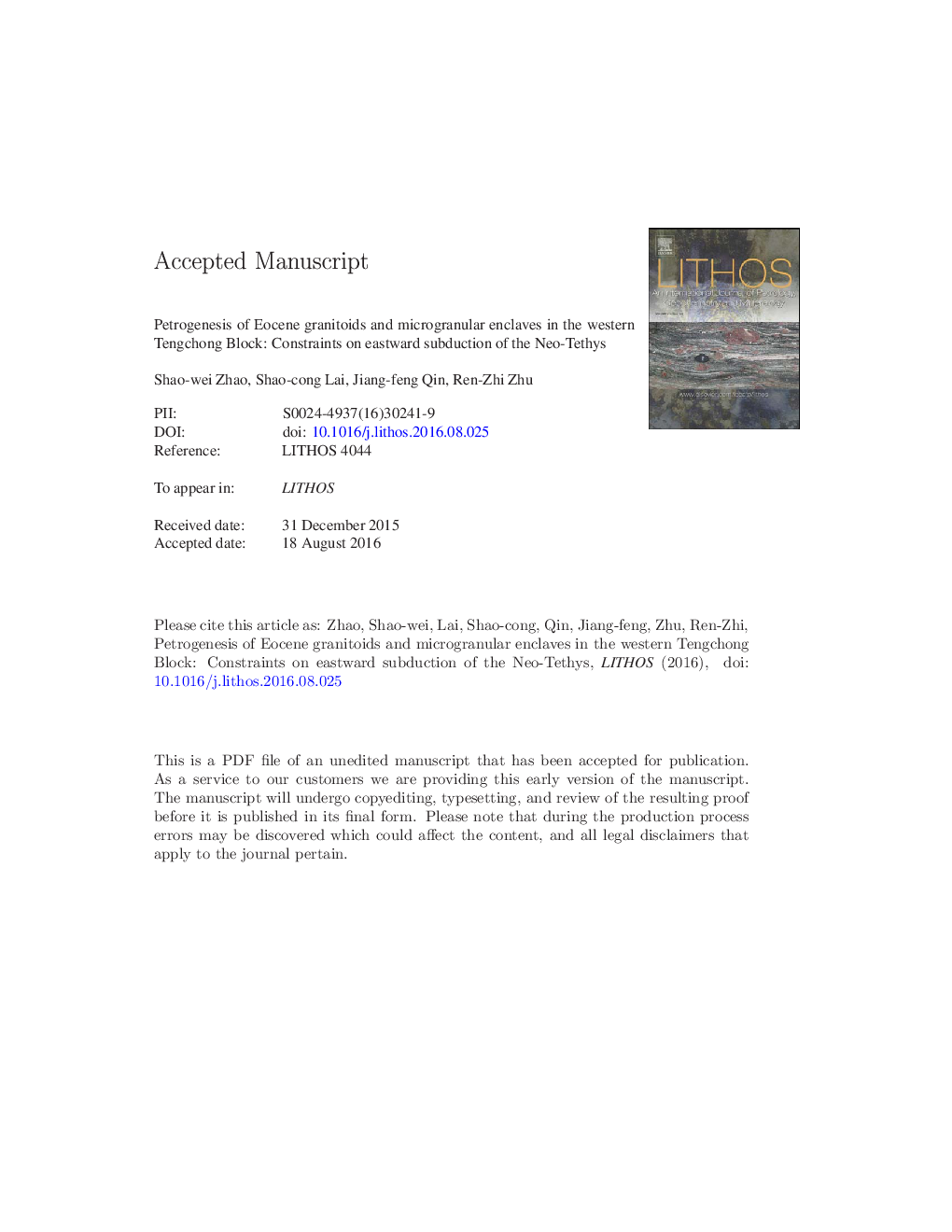| کد مقاله | کد نشریه | سال انتشار | مقاله انگلیسی | نسخه تمام متن |
|---|---|---|---|---|
| 6440233 | 1638640 | 2016 | 39 صفحه PDF | دانلود رایگان |
عنوان انگلیسی مقاله ISI
Petrogenesis of Eocene granitoids and microgranular enclaves in the western Tengchong Block: Constraints on eastward subduction of the Neo-Tethys
دانلود مقاله + سفارش ترجمه
دانلود مقاله ISI انگلیسی
رایگان برای ایرانیان
کلمات کلیدی
موضوعات مرتبط
مهندسی و علوم پایه
علوم زمین و سیارات
ژئوشیمی و پترولوژی
پیش نمایش صفحه اول مقاله

چکیده انگلیسی
Eocene granitic and related igneous rocks in the western Tengchong Block are considered to be the result of eastward subduction of Neo-Tethyan oceanic lithosphere beneath the Tengchong Block. In this paper we show that the granitic and mafic rocks in the western Tengchong Block exhibit a systematic compositional variation from west to east, with Na-rich granodiorites in the Nabang area (west) that differ from coeval high-K calc-alkaline granodiorites in the Bangwan area (east), and with tholeiitic mafic rocks in the Nabang area that differ from shoshonitic mafic microgranular enclaves (MMEs) in granodiorites of the Bangwan area. In addition, high-silica biotite granites were intruded into the granodiorites in the Bangwan area. The host granodiorites, MMEs, and biotite granites in the Bangwan area yield zircon U-Pb ages of ca. 50 Ma. The MMEs have relatively low SiO2 contents (53.1-64.95 wt%) and Mg# values (37-45), and high K2O (4.14-5.02 wt%) and â REE contents (331-509 ppm); the MMEs contain acicular apatites that indicate quenching. The host granodiorites also have high K2O (4.48-5.95 wt%) and â REE compositions (320-459 ppm), and together with the MMEs they are enriched in Th but depleted in Nb and Ti. The Sr-Nd-Pb isotopic compositions of the host granodiorites and the MMEs are similar, with εHf(t) values of â 1.0 to â 10.8 and 3.3 to â 11.1, respectively. The geochemical data and igneous textures suggest that the MMEs represent a mafic magma that was derived from the partial melting of mantle pyroxenite, with the melting induced by the influx of fluids/melts from the recycling of sediments in the subducted slab. The mafic melts then caused the partial melting of lower crustal tonalitic rocks to produce granodioritic magma that was subsequently mixed with mafic magma. The biotite granites have relatively high SiO2 contents and low Mg# values that indicate a purely crustal origin and derivation from the partial melting of upper crustal metagraywacke. The similar isotopic compositions of the biotite granites and the granodiorites can be interpreted to reflect the influence of fluids released during crystallization of the granodiorites. A comparison of contemporaneous Eocene granitic and mafic rocks in Nabang, Tongbiguan, Longchuan, and Bangwan in the Tengchong Block reveals that the mafic rocks vary from tholeiitic through high-K calc-alkaline to shoshonitic in composition from west to east, while the granitic rocks vary from Na- to K-rich. These systematic compositional variations indicate that the arc magmatism in the western Tengchong Block was the result of the eastward subduction of the Neo-Tethyan oceanic lithosphere. Fluids or/and melts from the subducted slab (including sediments) are likely to have played an important role in producing these compositional variations.
ناشر
Database: Elsevier - ScienceDirect (ساینس دایرکت)
Journal: Lithos - Volume 264, 1 November 2016, Pages 96-107
Journal: Lithos - Volume 264, 1 November 2016, Pages 96-107
نویسندگان
Shao-wei Zhao, Shao-cong Lai, Jiang-feng Qin, Ren-Zhi Zhu,